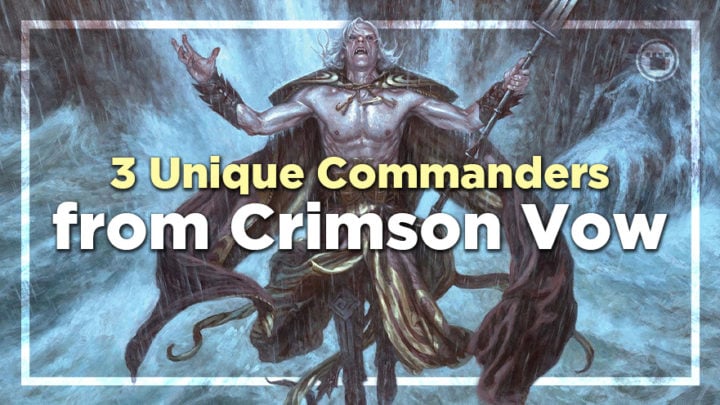Innistrad: Crimson Vow is descending upon us quickly. There’s an eternal night in Innistrad, and the plane’s spookier inhabitants are either in full force, or full regalia. What better way to celebrate the set’s release than by covering three interesting new Commander decks?
Some of the most famous faces from Innistrad take the helm of these decks, and each one is as different as the last. Each full deck is around $100, to ensure they’re within range of most budgets.
Katilda, Dawnhart Martyr – Aura Voltron
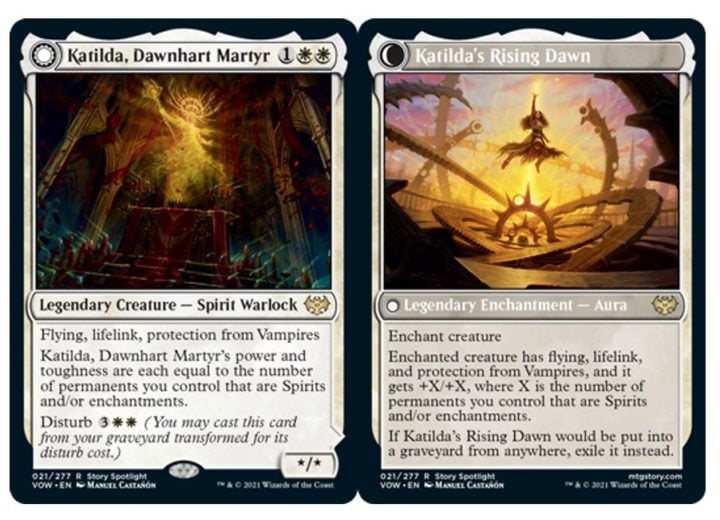
Katilda, Dawnhart Martyr is an interesting commander — not just in her current ability, but in her future potential. Currently, there aren’t many powerful Spirits in white, but that number can only increase in time. This makes her a great sleeper Spirits commander for now, but in the meantime, she can helm a fantastic Voltron deck!
Mono-White Voltron is nothing new, but her Ethereal Armor-esque ability is an effect we haven’t seen in the command zone yet. While Sram, Senior Edificer is a popular Voltron commander thanks to his card draw ability, Katilda gives you value by growing larger with each enchantment you play. This can help her become a lethal threat in no time, and her disturb ability can transform a random creature into a game-ending threat! The lifegain is also very relevant; many go-tall decks can lose to wide board states, and the extra life buffer can make all the difference. She’s also the perfect foil to any Vampire decks, thanks to her Vampire protection — perfect for getting back at all those Edgar Markov players!
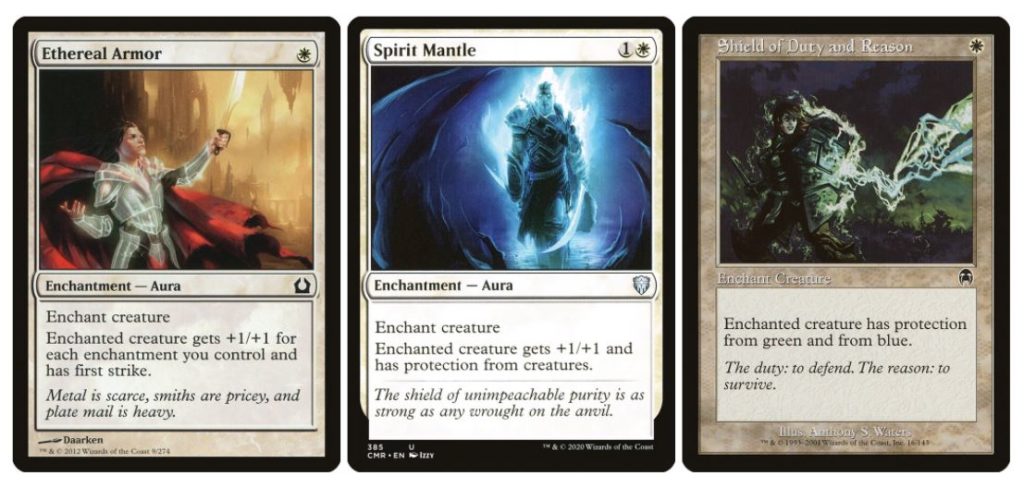
First, we need to suit up Katilda for battle! We’re using the usual suspects for white Auras, with the most important being the “continuous growth” Auras, like Ethereal Armor. Katilda essentially has the same ability, so each Aura will add even more to it! If you have Katilda and Ethereal Armor, she has two power and toughness; if you add All That Glitters, that turns into five power and toughness. The effects keep stacking, and before long, she will be more than capable of one-shotting opponents!
Spirit Mantle is a must-have Aura for every white Voltron deck. Katilda may have some evasion, but it’s never guaranteed to let her connect. Spirit Mantle deals with a board full of tokens, or even another Voltron commander. Unquestioned Authority is a second copy of this effect, except it also draws a card.
Shield of Duty and Reason and Mask of Law and Grace are Auras from Apocalypse and Urza’s Destiny, respectively. They’re incredible in a mono-white deck; one mana is a steal to give you protection from 40% of the color pie, especially when Katilda rewards you for playing more enchantments. You’re spoiled for choice in white for protection like this, and you can run more than usual with Katilda, making her a near-unkillable threat.

Unlike Sram, Senior Edificer, Katilda doesn’t have any inherent card draw attached; you’ll need to run more card draw than usual to make sure you don’t run out of gas. Angelic Gift might seem unusual, considering Katilda already has flying, but Auras that replace themselves are ideal in this sort of deck. Katilda grows from them already, so this card technically reads “Enchanted creature gets +1/+1 and has flying” (or +2/+2 with Ethereal Armor).
Armored Skyhunter has continually impressed me in Voltron strategies, and I’d suggest including it whenever possible. You can grab an Aura from the top of your deck and completely change the tide of battle, and you can do so repeatedly, provided you keep attacking. It’s a brilliant source of repeated card advantage, and it doubles as a secondary threat.
We also have access to some classic card draw spells, including Three Dreams — the poster child for Aura-based card draw. Five mana might seem like a lot, but you’ll get to tutoring for three incredibly impactful spells. Mesa Enchantress will also serve you well here, as you’re essentially playing an offshoot of Enchantress.
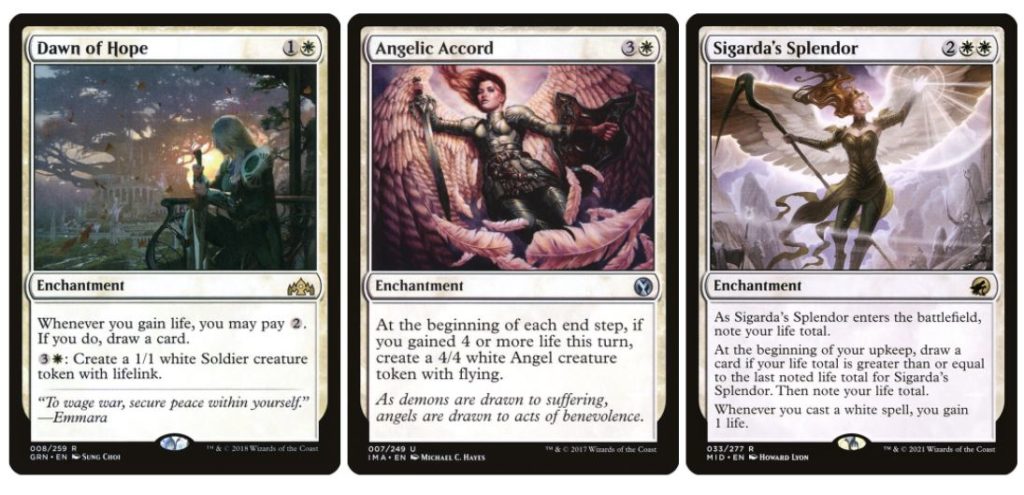
Thanks to Katilda’s lifelink, you’ll regularly gain a lot of life with this deck. There are a number of ways you can take advantage of this to ensure you get the most out of her abilities. Dawn of Hope is a great way to draw an extra card per turn, and to create emergency blockers, if needed. It can come down early and start developing a board if you’re light on action, and it enables itself if you need to refill your hand later on.
Angelic Accord can make a team of flyers to keep counterattacks at bay while you close the game with your commander. It may be tricky to enable this on opponents’ turns, but even one flyer per turn for almost no mana investment is still a fantastic deal.
This deck is in a unique position to take advantage of many of white’s newer card advantage spells, with Sigarda’s Splendor being the newest. It will take a couple of turns to get your mana investment back from it, but you’ll get a card for every turn it sticks around.
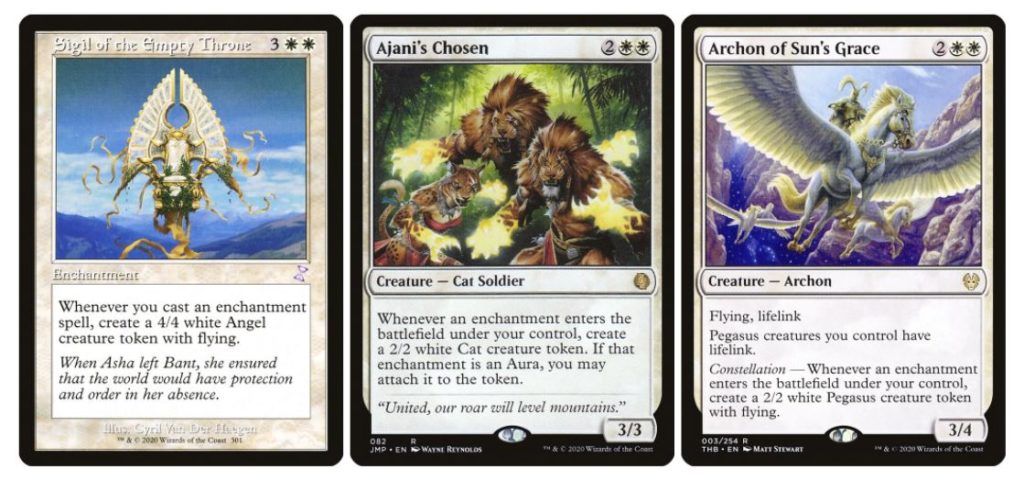
The classic white Enchantress win cons are all present here, with Sigil of the Empty Throne being the most famous. Every little Aura becomes a threat, which will snowball out of control in no time. If your opponents don’t remove it quickly, they could easily fall victim to the most lethal form of incidental value: free large flyers!
Ajani’s Chosen is one of the few ways you can move Auras around on creatures, giving you scope to diversify your threats in a pinch. It may produce the least useful token in this group, but with a critical mass of Cats, you can go toe-to-toe with more densely populated decks.
Finally, Archon of Sun’s Grace works very similarly to Sigil of the Empty Throne, except it gives lifelink to the tokens it creates. This is imperative for winning damage races, and the Pegasus can be a great target for an All That Glitters if Katilda is preoccupied.
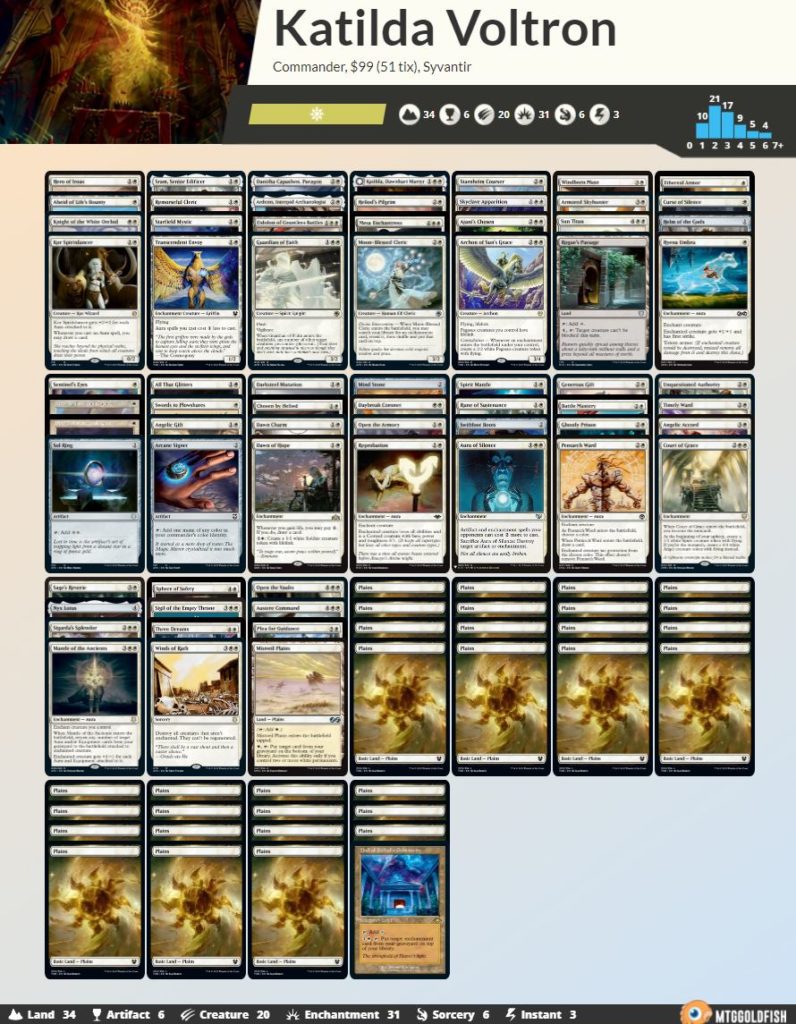
Katilda has the potential to be an extremely potent Voltron commander. She may not surpass Sram in the polls, but people’s underestimation of her strength could make her an excellent secret weapon and a worthy ally.
Geralf, Visionary Stitcher – Walls
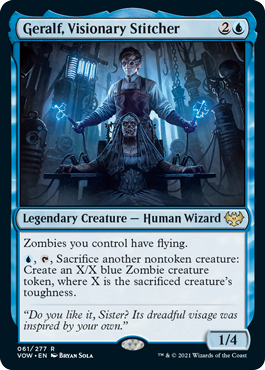
Geralf is known for many things in Magic, most notably his infatuation with Zombies. His abilities make him a fantastic addition to any Zombie deck, like Wilhelt, the Rotcleaver or Varina, Lich Queen. What drew me to Geralf, however, was his activated ability. “Toughness matters” isn’t something you see often, especially in mono-blue, so I took this as a challenge to make something really unique: Mono-Blue Walls!
Walls generally have high toughness at a low mana cost, and they’re perfect sacrifice fodder to amass a flying Zombie army with Geralf. They also give you an extremely solid defense, and they can even enable a few alternate win conditions!
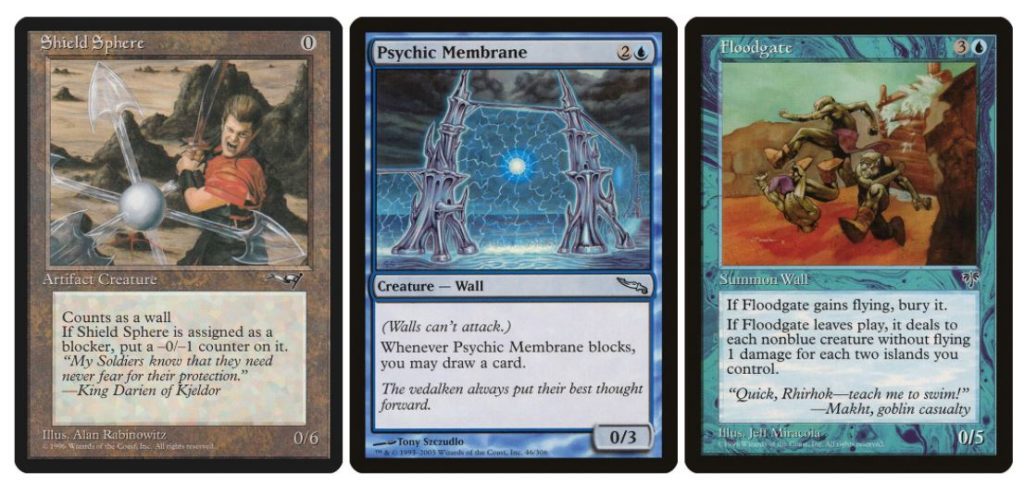
First up, we need some Walls. There are a surprising number of useful Walls in blue, as well as a number of colorless artifact ones. Shield Sphere is the most efficient in terms of stats — you can turn it into a 6/6 flying Zombie with Geralf!
Not all Walls are just vanilla creatures, however: some of them have uniquely useful abilities, like Psychic Membrane. Any time an opponent attacks you, you can effectively convert that attack into an extra card. If the Wall would take lethal damage from an attack, you can sacrifice it to Geralf before damage for maximum value!
Floodgate is a bizarre card from Mirage that can act as a sort of board wipe, dealing damage to non-blue, non-flying creatures when it leaves play. If you’re careful with the creatures you play and the number of Islands you have on board, you can use this to cut down a number of problems while leaving your creatures untouched.
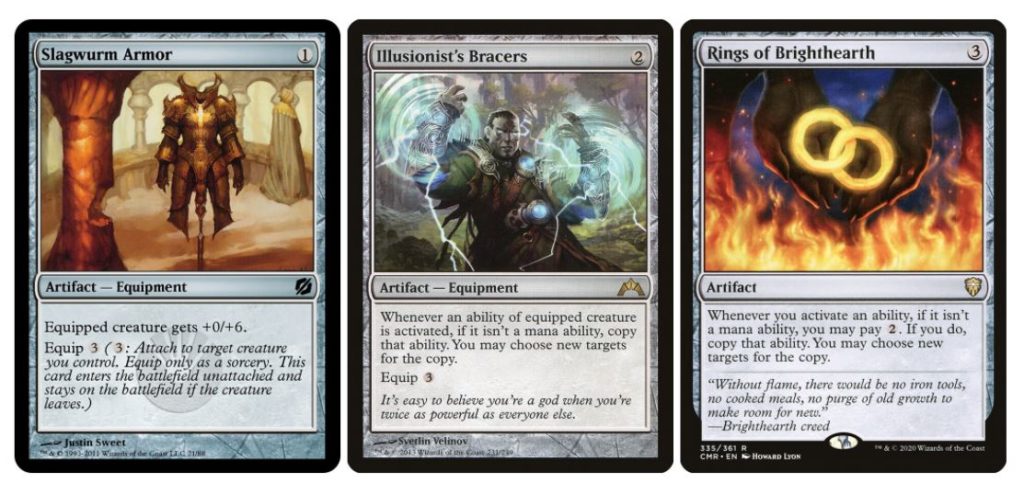
Next, let’s look at some other ways to maximize Geralf’s ability. Slagwurm Armor is a cheap Equipment that adds a whopping six toughness to any creature. Geralf can now turn Shield Sphere into a 12/12 flyer, which is an unbelievable rate!
Illusionist’s Bracers is one of the pricier cards in the deck, but it’s worth it for a Doubling Season-like effect. Every time you sacrifice a creature, you’ll make two tokens instead of one, doubling your damage output.
Rings of Brighthearth can also double up Geralf’s ability. When you pair it with Illusionist’s Bracers, three mana can turn a Wall into three flying Zombies!
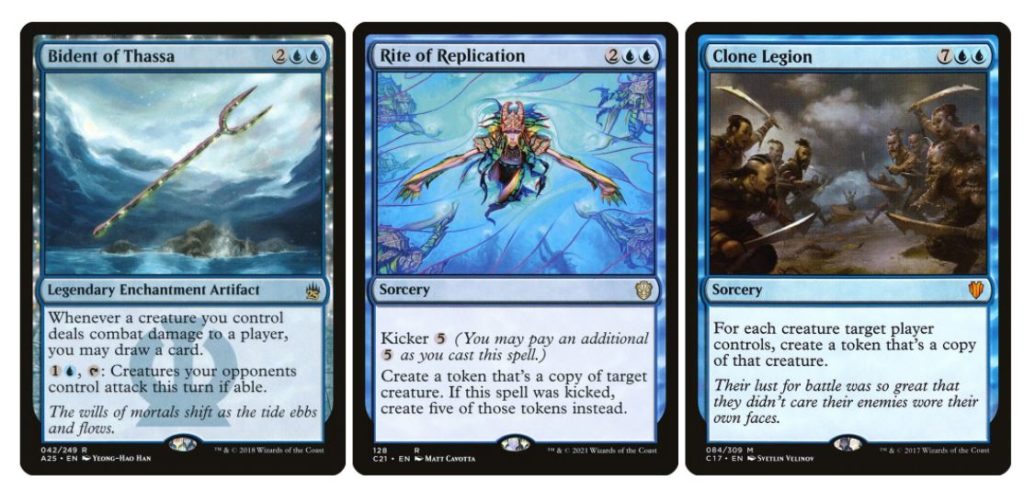
The best way to accrue advantage is through the Zombie tokens themselves. Effects like Bident of Thassa or Coastal Piracy let you take advantage of the evasion Geralf gives your team. With just a couple of Zombies on board, you’ll be drawing several extra cards per turn.
If a few tokens aren’t enough for your tastes, why not make more? Rite of Replication is a classic copy spell that can really get out of hand, especially with your larger tokens. If you kick this on a single 7/7 Zombie, you’ll be adding 35 power worth of flyers to the board!
If you really want an explosive turn, Clone Legion is the weapon of choice. You can double the size of your board if you’re ahead, or duplicate an opponent’s creatures to catch back up when you fall behind. No matter how you use it, this spell will almost always break the game wide open, giving you a chance to go for the win.
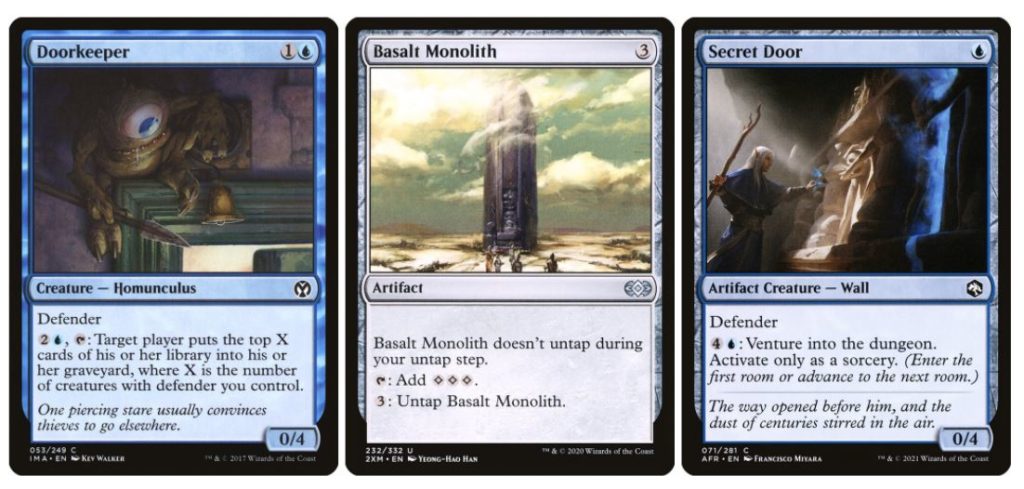
The win conditions in this deck are extremely varied, to give you multiple angles of attack. First off, as you’re running a slew of Walls, Doorkeeper can be a respectable mill win condition, especially in conjunction with Rings of Brighthearth. If you find milling opponents out to be too much work, you can always mill yourself and win with a very thematically appropriate Laboratory Maniac!
Basalt Monolith is another easy addition to give you an infinite mana combo (read more in my article on Budget Commander Combos). With infinite mana, you can copy Basalt Monolith’s untap ability with Rings to untap a land or mana rock for colored mana. This way, you’ll either force opponents to lose to an arbitrarily large Blue Sun’s Zenith, or you can target yourself for another Lab Man win.
One final win condition that’s perfectly on theme is Secret Door. If you generate infinite mana with your Monolith and Rings combo, you can repeatedly venture into the Lost Mine of Phandelver to drain your opponents out!

Geralf probably wasn’t designed to be a commander, but rather a powerful support piece for Zombie decks. Regardless, I think this is one of the more unique decks I’ve found in quite some time. With the right approach, just about any legendary creature can become a fantastic commander.
Runo Stromkirk – Sea Creatures
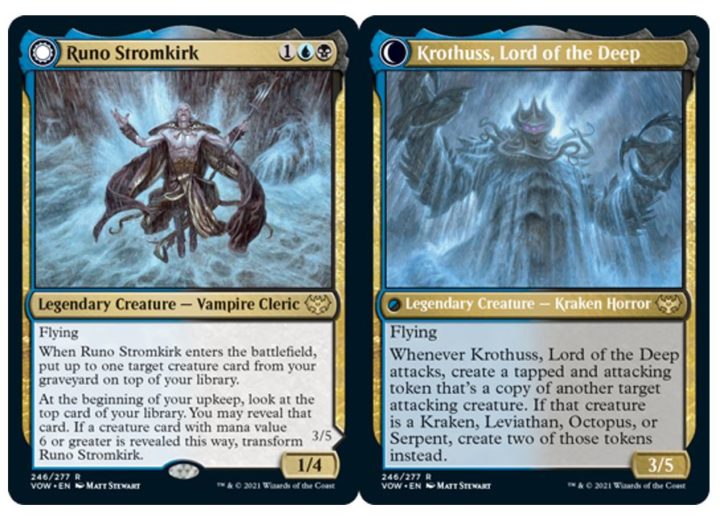
Goodbye, Wrexial, the Risen Deep. This is the Sea Creatures commander we’ve all been waiting for. Runo’s initial effect seems to be there purely to set him up to flip on the following turn; it may seem like a few hoops to jump through, but it’s surprisingly easy to pull off if you build the deck right!
Once Runo has turned into Krothuss, Lord of the Deep, the real party starts. Copying creatures when he attacks is already good, but making two copies of sea creatures will give you an enormous board presence in no time! Krothuss’s flying makes it pretty easy to attack, too, so you’re more likely to copy a creature every turn. The best part, however, is that these tokens don’t disappear at the end of the turn, meaning you can keep building up your board by attacking!
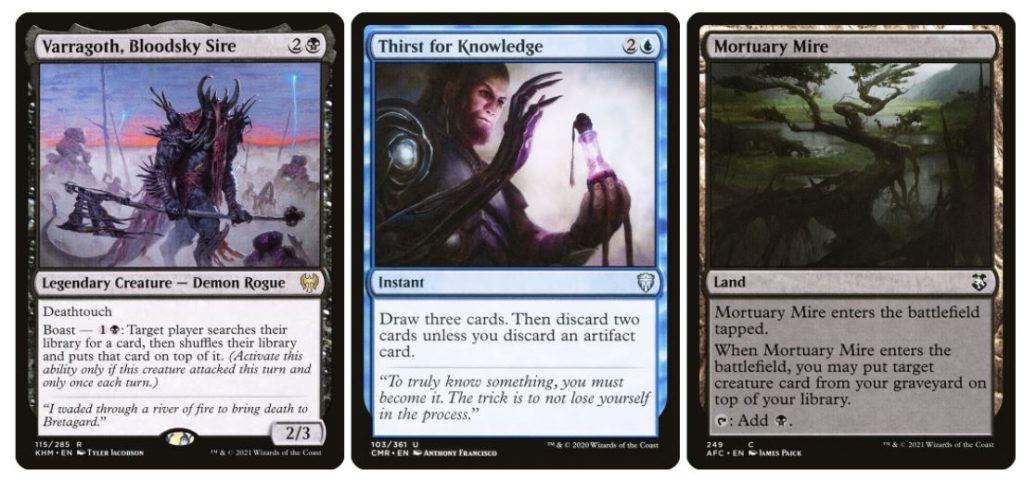
First thing’s first: we need Runo to transform as easily as possible. Varragoth, Bloodsky Sire is an extremely reliable way to put a massive creature on top of your library and turn Runo into Krothuss. Outside of that, you can use him politically by offering your opponents a tutor effect in exchange for a favor, or use him yourself to pick up the right card at the right time.
Since Runo can put a creature from the graveyard on top of the library, you can use powerful filtering cards like Thirst for Knowledge to help enable his ability. These spells are also exceptional at increasing card velocity; you’ll need to ensure you hit your land drops to play your enormous creatures, so these spells add another level of consistency to your game plan.
If Runo is already on board, you can use two lands to place a creature from the graveyard on top of the library: Mortuary Mire and Witch’s Cottage. They’re effectively free spells that only take up land slots, but they can make all the difference in transforming Runo.
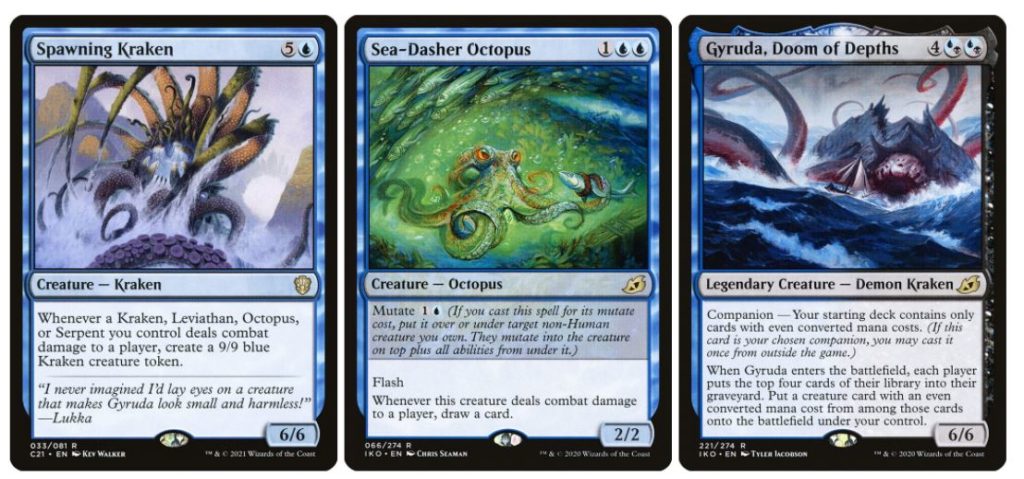
In order to make the most of Runo, you need some powerful sea creatures. Spawning Kraken is a terrifying creature itself, but your opponents will be devastated if you make two copies with Runo. If each Spawning Kraken deals combat damage, you’ll end up with nine 9/9’s (81 power) from the triggered abilities alone! Your opponents will need an immediate board wipe or risk losing the game at that point.
Sea-Dasher Octopus is a neat little repeatable card draw engine. What it lacks in hulking mass, it makes up for in card advantage! You can even mutate it onto one of your bigger creatures to make it easier to attack with. If Runo copies the mutated creature, the copies will retain the Curiosity effect!
If you just want to swing out with massive hulking sea beasties, Gyruda will certainly help you find them! This deck isn’t built to take full advantage of Gyruda — nor does Runo’s copy ability work well with legendary creatures — but the copies will still trigger all of their enter-the-battlefield abilities. This is one of the more chaotic elements to the deck, and it may not work very well over Spelltable, but it ranges from being funny to an unforgettable spectacle when it does go off!
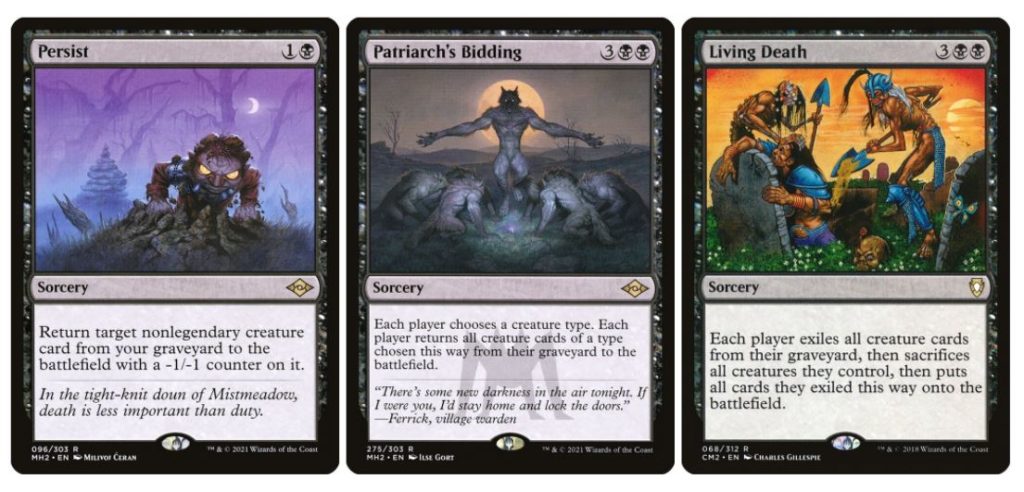
You weren’t expecting to pay full retail for those enormous sea creatures, right? Since you’re filtering so many cards through your hand and into your graveyard, it makes sense to add a small reanimation package to make developing your board a little easier. Persist is a cheap and efficient way to reanimate a Krakens or Leviathans with little downside, which can help you apply pressure as early as turn two.
Patriarch’s Bidding will help you bring back several Krakens at once, as they’re the most common creature type in the deck. There are multiplies of the other creatures, but you’re more likely to get maximum value from Krakens than anything else.
Living Death is one of the best ways to get a full board while dealing with threats at the same time. Even returning a couple of creatures is amazing value, especially when it comes attached to a board wipe! Effects like this are best when Runo is otherwise indisposed or tied up, where you can pivot into a sort of pseudo-reanimator deck without losing steam.
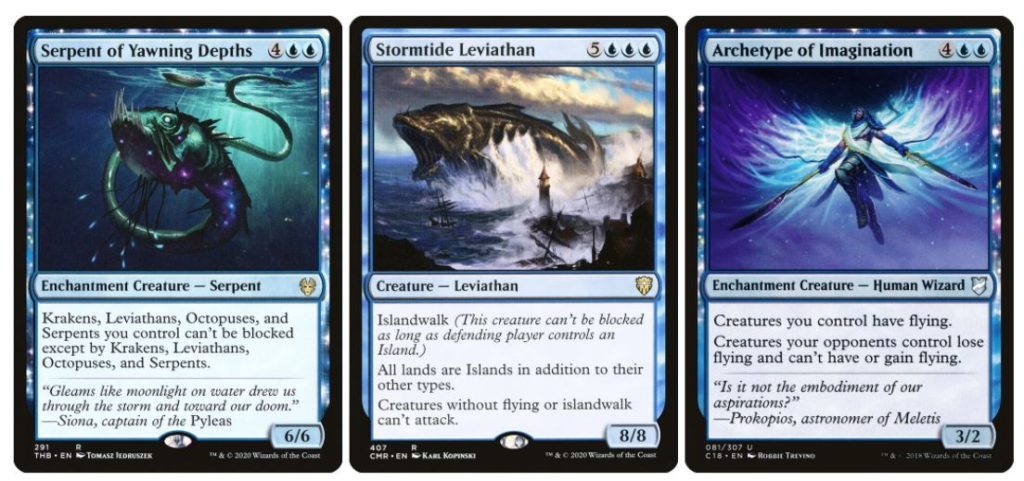
When you’re cheating in and copying some of the biggest creatures in Magic, you don’t need many more dedicated win conditions. You’ll mainly be looking for ways to force through damage, as most of your creatures lack evasion. Serpent of Yawning Depths can help by making your school of sea creatures unblockable.
Stormtide Leviathan is perfect for locking down opposing board states, saving you from death by retaliation. This is particularly effective with Krothuss: he can still attack thanks to flying, and he can make more Stormtide Leviathans, making it even harder to remove the lockdown effect.
If you really want to shut down your opponents’ boards, Archetype of Imagination combos with Stormtide Leviathan beautifully. With both of them on board, your opponents can’t attack, and they probably can’t block your creatures, either. It’s not a particularly friendly way to win, but you may not need it for long when you’re swinging with multiple monstrosities!
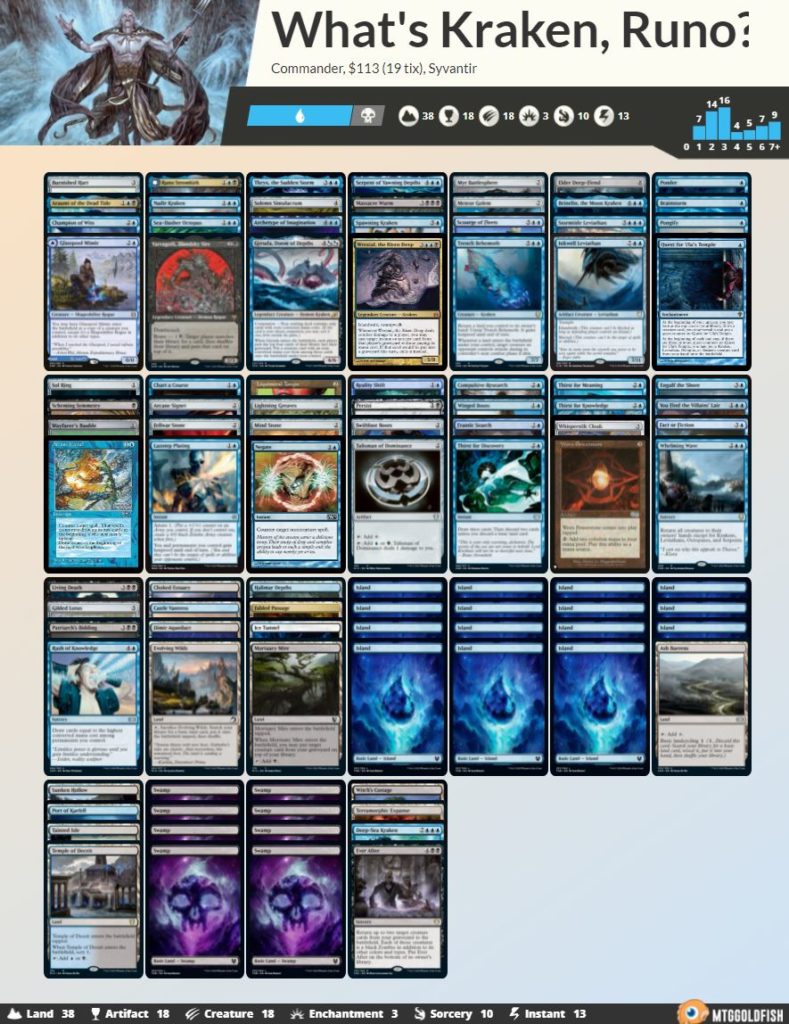
Runo is fantastic. I’ve always wanted a home for my Krakens and Serpents, and this feels like the right commander to take the helm. It’s a unique design with an interesting minigame attached, and once Krothuss is online, it feels incredible. This commander could turn Sea Creatures from a meme into a dream come true!
Once again, Wizards gave us some awesome new commanders with the latest set. These are just three of the many new legendary creatures from Innistrad: Crimson Vow, and there are countless possibilities for building them. I hope these decks gave you some inspiration or ideas to build a new commander deck from this set!
What did you think of these decks? Do you have any cards you’d like to add to them? Which legendary creatures from Crimson Vow would you like to see us build? I’d love to hear from you over on Twitter!

Scott is an Irish content creator and the Head of Budget Magic for the Izzet League. He focuses on affordable decks in Pioneer, Modern, and Pauper, particularly ones that stray from the mainstream. When he’s not writing about his favorite decks, he can be found talking incessantly about them on Twitter and on The Budget Magic Cast.

